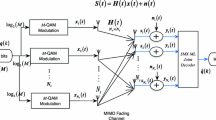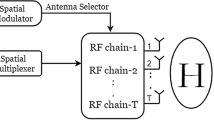Abstract
The mid-symbol antenna transition (MAT) approach reduces the number of transmitter antennas in spatial modulation (SM) systems. This paper studies the performance of MAT technique over correlated and uncorrelated wireless channels. We focus on the scenario wherein the channel consists of multiple paths with a line of sight component, i.e., Rician fading channel. An accurate closed form for the average bit error rate (ABER) performance of the MAT approach is derived. Traditional SM, generalized SM (GSM), and variable generalized SM (VGSM) approaches are used as benchmarks to evaluate the considered MAT approach. Simulation results validate the accuracy of the derived ABER closed form. Performance enhancements, in terms of ABER, of the MAT approach compared to SM, GSM, and VGSM approaches are affirmed analytically and by simulation results.







Similar content being viewed by others
References
Mesleh, R. Y., Haas, H., Sinanovic, S., Ahn, C. W., & Yun, S. (2008). Spatial modulation. IEEE Transactions on vehicular technology, 57(4), 2228–2241.
Younis, A., & Mesleh, R. (2018). Information–theoretic treatment of space modulation MIMO systems. IEEE Transactions on Vehicular Technology, 67(8), 6960–6969.
Di Renzo, M., Haas, H., Ghrayeb, A., Sugiura, S., & Hanzo, L. (2014). Spatial modulation for generalized MIMO: Challenges, opportunities, and implementation. Proceedings of the IEEE, 102(1), 56–103.
Younis, A., Serafimovski, N., Mesleh, R., & Haas, H. (2010). Generalised spatial modulation. In: IEEE (pp. 1498–1502).
Younis, A. (2014). Spatial modulation: theory to practice, Ph.D. dissertation, University of Edinburgh.
Arafa, M., Elwekeil, M., & Dessoky, M. (2018). Mid-symbol duration antenna transition approach for performance enhancement of spatial modulation. Electronics Letters, 54(8), 506–507.
Simon, M. K., & Alouini, M.-S. (2005). Digital communication over fading channels (Vol. 95). London: Wiley.
Van Zelst, A., & Hammerschmidt, J. (2002). A single coefficient spatial correlation model for multiple-input multiple-output (MIMO) radio channels. In Proceedings of the 27th Gneral Assembly URSI, Maastricht, The Netherlands. (pp. 1–4).
Proakis, J. G., & Salehi, M. (2001). Digital communications (Vol. 4). New York: McGraw-Hill.
Hedayat, A., Shah, H., & Nosratinia, A. (2005). Analysis of space-time coding in correlated fading channels. IEEE Transactions on Wireless Communications, 4(6), 2882–2891.
Mesleh, R., & Alhassi, A. (2018). Space modulation techniques. New York: Wiley.
Turin, G. L. (1960). The characteristic function of Hermitian quadratic forms in complex normal variables. Biometrika, 47(1/2), 199–201.
Author information
Authors and Affiliations
Corresponding author
Additional information
Publisher's Note
Springer Nature remains neutral with regard to jurisdictional claims in published maps and institutional affiliations.
Rights and permissions
About this article
Cite this article
Arafa, M., Dessouky, M. & Elwekeil, M. Performance analysis of mid-symbol antenna transition spatial modulation approach over Rician fading channels. Wireless Netw 27, 2015–2022 (2021). https://doi.org/10.1007/s11276-020-02530-w
Accepted:
Published:
Issue Date:
DOI: https://doi.org/10.1007/s11276-020-02530-w




